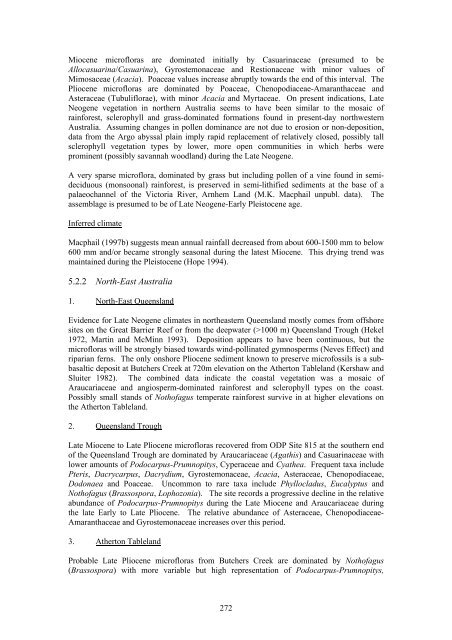OFR 151.pdf - CRC LEME
OFR 151.pdf - CRC LEME
OFR 151.pdf - CRC LEME
You also want an ePaper? Increase the reach of your titles
YUMPU automatically turns print PDFs into web optimized ePapers that Google loves.
Miocene microfloras are dominated initially by Casuarinaceae (presumed to be<br />
Allocasuarina/Casuarina), Gyrostemonaceae and Restionaceae with minor values of<br />
Mimosaceae (Acacia). Poaceae values increase abruptly towards the end of this interval. The<br />
Pliocene microfloras are dominated by Poaceae, Chenopodiaceae-Amaranthaceae and<br />
Asteraceae (Tubuliflorae), with minor Acacia and Myrtaceae. On present indications, Late<br />
Neogene vegetation in northern Australia seems to have been similar to the mosaic of<br />
rainforest, sclerophyll and grass-dominated formations found in present-day northwestern<br />
Australia. Assuming changes in pollen dominance are not due to erosion or non-deposition,<br />
data from the Argo abyssal plain imply rapid replacement of relatively closed, possibly tall<br />
sclerophyll vegetation types by lower, more open communities in which herbs were<br />
prominent (possibly savannah woodland) during the Late Neogene.<br />
A very sparse microflora, dominated by grass but including pollen of a vine found in semideciduous<br />
(monsoonal) rainforest, is preserved in semi-lithified sediments at the base of a<br />
palaeochannel of the Victoria River, Arnhem Land (M.K. Macphail unpubl. data). The<br />
assemblage is presumed to be of Late Neogene-Early Pleistocene age.<br />
Inferred climate<br />
Macphail (1997b) suggests mean annual rainfall decreased from about 600-1500 mm to below<br />
600 mm and/or became strongly seasonal during the latest Miocene. This drying trend was<br />
maintained during the Pleistocene (Hope 1994).<br />
5.2.2 North-East Australia<br />
1. North-East Queensland<br />
Evidence for Late Neogene climates in northeastern Queensland mostly comes from offshore<br />
sites on the Great Barrier Reef or from the deepwater (>1000 m) Queensland Trough (Hekel<br />
1972, Martin and McMinn 1993). Deposition appears to have been continuous, but the<br />
microfloras will be strongly biased towards wind-pollinated gymnosperms (Neves Effect) and<br />
riparian ferns. The only onshore Pliocene sediment known to preserve microfossils is a subbasaltic<br />
deposit at Butchers Creek at 720m elevation on the Atherton Tableland (Kershaw and<br />
Sluiter 1982). The combined data indicate the coastal vegetation was a mosaic of<br />
Araucariaceae and angiosperm-dominated rainforest and sclerophyll types on the coast.<br />
Possibly small stands of Nothofagus temperate rainforest survive in at higher elevations on<br />
the Atherton Tableland.<br />
2. Queensland Trough<br />
Late Miocene to Late Pliocene microfloras recovered from ODP Site 815 at the southern end<br />
of the Queensland Trough are dominated by Araucariaceae (Agathis) and Casuarinaceae with<br />
lower amounts of Podocarpus-Prumnopitys, Cyperaceae and Cyathea. Frequent taxa include<br />
Pteris, Dacrycarpus, Dacrydium, Gyrostemonaceae, Acacia, Asteraceae, Chenopodiaceae,<br />
Dodonaea and Poaceae. Uncommon to rare taxa include Phyllocladus, Eucalyptus and<br />
Nothofagus (Brassospora, Lophozonia). The site records a progressive decline in the relative<br />
abundance of Podocarpus-Prumnopitys during the Late Miocene and Araucariaceae during<br />
the late Early to Late Pliocene. The relative abundance of Asteraceae, Chenopodiaceae-<br />
Amaranthaceae and Gyrostemonaceae increases over this period.<br />
3. Atherton Tableland<br />
Probable Late Pliocene microfloras from Butchers Creek are dominated by Nothofagus<br />
(Brassospora) with more variable but high representation of Podocarpus-Prumnopitys,<br />
272

















